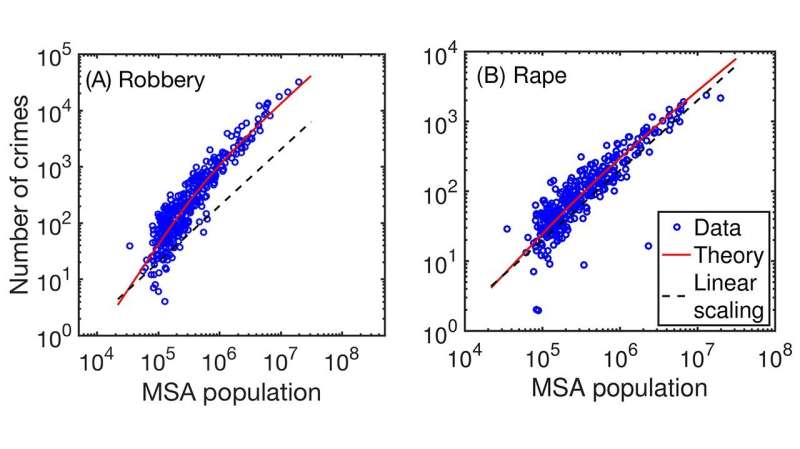Bigger cities boost 'social crimes'

As cities grow in size, crime grows even faster. But while certain types of crime—car theft and robbery, for example—exponentially outpace the population, other crime categories buck the trend. Rape, for example, grows only linearly, at roughly the same pace as a city's population.
Why it is that only some crimes supercharge from city size is explained in a new paper published this week in Physical Review E. According to the paper, the same underlying mechanism that boosts urban innovation and startup businesses can also explain why certain types of crimes thrive in a larger population.
"The variation among scaling relationships for crime has troubled researchers for a long time," says lead author Vicky Chuqiao Yang (Santa Fe Institute, Northwestern University). "This work says the variations are not a bug, but a feature."
According to Yang and her coauthors Andrew Papachristos and Daniel Abrams (both of Northwestern University), certain crimes are "social" in nature and require a team effort. Going by data from the National Incident-Based Reporting System, an average of ~1.6 offenders were arrested or reported per robbery, and ~1.5 per motor vehicle theft—relatively high numbers considering that only a small subset of offenders wind up getting arrested or listed in crime reports. By contrast, reporting data for rape, a crime often committed by a lone individual, hovered closer to one.
The more people involved in a crime, the more they seem to benefit from the population power of the city. Because the incidence of social crimes grows superlinearly with city population, the researchers hypothesized that social crimes thrived on making the right connections— in this case, the ability to find collaborators who are willing and able to rob and steal.
To test their hypothesis, the researchers created a mathematical model that predicted the volume of crime as a function of social interactions. Because a higher population increases the number of unique contacts an individual criminal can choose from, that offender has a better chance of finding the right team of collaborators. Predictably, the incidence of social crimes then rises with a city's population disproportionally while solitary crimes stay roughly linear.
Though the current paper focuses on explaining crime data, the researchers stress that their model also applies to other socioeconomic quantities like innovation and productivity. Previous work in the "science of cities" has shown that innovation scales superlinearly with city size, and that social interactions might be fueling that growth. The new model builds on that understanding, as social interactions increase the probability of finding the right collaborators—either for starting a business or boosting a car.
"Bigger cities are a double-edged sword," Yang remarks. "What leads to more innovation and wealth in bigger cities also makes them more dangerous at the same time."
More information: V. Chuqiao Yang et al. Modeling the origin of urban-output scaling laws, Physical Review E (2019). DOI: 10.1103/PhysRevE.100.032306
Journal information: Physical Review E
Provided by Santa Fe Institute



















